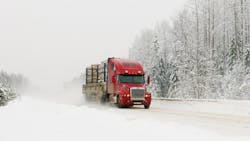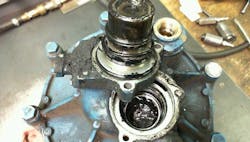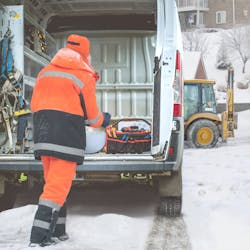Vibrant, fiery-hued foliage is still lining the roads of the northern U.S. and Canada (at the time this story is published), but soon the trees will be barren and covered in pure white snow, while the roads will be slick with an ashen gray mixture of slush and salt. The good news is you likely have a month or two to brace your fleet before winter kicks into high gear (excluding the Dakotas, Montana, and Canada, of course, where you may have mere hours).
But you should start getting ready ASAP, because winterizing your fleet now will save you money come January.
“Preparation before winter is certainly less expensive than a failure on the road,” said Tom Stencil, regional sales representative at Eberspaecher, whose career has also included working as a truck driver and a technician. “Drivers want to deliver their loads and not lose time and money. For fleets, the high cost of repairs impacts efficiency and driver satisfaction and leads to poor ratings from customers.”
Read more: Considerations for winterizing vehicles
Luckily, there is still time to prevent weather-related issues from happening by getting equipment ready for winter operation. To help plan, a range of experts weighed in on winterizing best practices for critical systems, what happens if those are not done, and the benefits of being prepared.
Batteries
“A lot is asked of electrical systems in cold weather,” said Daniel Mustafa, director of technical service for TravelCenters of America. “Batteries need to crank over cold engines, and they charge slower. Lights are on longer due to reduced daylight hours, and a battery’s freezing point changes when cold temperatures cause water and electrolytes to separate.”
To prevent problems, Mustafa recommended avoiding unnecessary battery drain by unplugging cab and sleeper items when they’re not needed. When a truck is parked, make sure load disconnect switches are deactivated, he advised. That will allow essential items to function while preventing voltage drops from components that draw power even when they’re not being used.
“We recommend testing electrical systems before the weather changes,” Mustafa added. “Using tools like an AutoMeter, our technicians can evaluate things like battery cable integrity. That not only predicts the life of the components but also presents an opportunity to prevent a breakdown.”
The summer ruins batteries, but the winter brings out the problems, noted Larry Rambeaux, sales application engineer at Purkeys. “If you go into winter without having taken care of things, then you have an increase in jump starts, and if drivers are worried about the truck not starting, idling goes up because they’re afraid to shut off the truck,” he said. “If you properly maintain batteries before extreme winter cold, you will have improved life and performance for all electrical components.”
Read more: Best practices for winterizing CV batteries
Rambeaux’s advice also included using quality testing equipment for batteries, voltage drop, cranking and charging circuits, and the alternator. Those tests must be done to make sure the entire system is working properly, he noted, and it’s important to maintain and properly calibrate the testing equipment.
Alan Kohler, senior marketing manager at Odyssey, said lead acid batteries often lose some of their operational capacity when subjected to an extremely cold environment. “A temperature of 0 degrees F, for example, diminishes power by about 30%,” he related. “If it’s cold enough for the oil to thicken, the battery must expend more energy to start the engine.”
Winterizing a heavy-duty vehicle’s battery involves inspecting, cleaning, testing, and charging. Kohler recommended the following:
- Check conventional, flooded lead acid battery electrolyte levels, and add distilled water to replenished cells if needed.
- Inspect the case, terminals, cables, and clamps for damage from wear and corrosion. This would appear as a thin, white powder or a blue-green growth. Apply dielectric grease, anti-corrosion spray, or petroleum jelly to the terminals after cleaning.
- Measure Open Circuit Voltage (OCD) and determine the battery’s State of Charge (SOC) after the battery sits for at least six hours, and after it has been charged, to ensure chemical reactions reach equilibrium and the surface charge is gone.
Electrical systems
One way to help winterize your wiring is by spec’ing a sealed wire harness, said Andy Summers, director of fleet sales at Phillips Industries. This helps keep out moisture and debris. Failure to do so can result in drops in power, leading to flickering, intermittent, or non-working lights, which are both safety hazards on the road and CSA violations.
Aside from regular cleaning and greasing of lighting connections, Summers stressed that it’s vital to keep the 7-way connections clean at the front of the trailer.
“In regions where deicers are commonly used, more frequent cleaning and the application of dielectric grease on plugs and sockets on both the tractor and trailer are essential to counteract the corrosive effects of these chemicals,” Summers said.
Read more: Why you should add ADAS to winter maintenance routines
Ensuring proper cable support by tightly affixing lights to their pigtail connections and the chassis frame is essential to protect cables from sharp edges or rubbing against the trailer’s frame. Summers explained this could compromise the jacketing or cause the cables to become dislodged or damaged.
Regularly maintained mud flaps play a dual role in keeping large road debris like rocks from kicking up and in creating a barrier against moisture and contaminants that can compromise electrical connections, he said.
Summers warned to take extra care when cutting or splicing sealed harnesses or when pressure washing vehicles, emphasizing the importance of keeping moisture away from couplings such as plugs, sockets, lamp pigtails, and harness connections.
“It’s vital to ensure wires are properly seated in terminals for a strong connection, and any repairs should be sealed to keep moisture out and maintain the integrity of the harness,” he said. “High-pressure water can force moisture into these components, potentially causing electrical issues or corrosion.”
Fuel systems
Diesel fuel gels when it’s cold. In addition to clogging fuel systems, it won’t flow or burn. Hot fuel cools when the truck isn’t running, and cool outside temperatures cause moisture to collect in the tank, explained Jamie Hagen, owner of Hell Bent Xpress and a former driver. “We use a quality anti-gel additive all winter long and keep our tanks full at night to prevent condensation from occurring,” he explained. “Full tanks gather no moisture.”
Fuel gelling can also be prevented by using locally purchased fuel in colder areas because it’s blended or treated, TA’s Mustafa noted. In any of those cases, he recommended removing the fuel and sweeping the tank to remove excess water. The fuel filter should be changed, and the fuel/water separator should be drained.
“Anti-gel additives can pre-treat fuel as well,” Mustafa added, and there are great products like Diesel 911 when you already have a problem.”
Air systems
Rick Conklin, Bendix director of engineering, air supply, and drivetrain, noted that winter conditions increase the vulnerability of air systems. In particular, he recommended the following:
- Drain the air tanks manually at the beginning of the cold weather season to get rid of any moisture from warmer months.
- Check the air dryer cartridge. If it hasn’t been replaced lately, replacement may be wise before the winter season hits because moisture in the air system can condense and freeze, upping the chances of brake and valve malfunctions.
- Replace the purge valve if you spot corrosion or grit accumulation. Corrosive road chemicals—the kind you’ll run into during winter—can damage this valve and cause bigger system issues.
“The largest issue with air systems in winter is water freezing that prevents critical systems from functioning,” Mustafa said, “and the easiest way to prevent it is to not let it in. Changing the air dryer filter is a low-cost item that can save a lot of pain. Draining air tanks as part of a pre-trip inspection is also an undervalued procedure.”
For Hell Bent Xpress’ Hagen, changing air system filters is a standard practice. “We only use high-quality products in this application as cheaper ones have led to issues,” he emphasized. “We also purge all of our truck and trailer air tanks.”
Braking systems
The importance of brake performance heightens in winter, noted Mark Holley, Bendix director of marketing and customer solutions, wheel-end, so preventive maintenance is imperative before the systems are put to the test and should include the following:
- Check air brake chamber housings for corrosion or damage and make sure dust plugs are properly installed, which helps prevent corrosive materials from taking hold.
- Regular lubrication on drum-braked wheel ends keeps moisture from building up and enabling corrosion. Also, make sure automatic slack adjusters, clevis pin connections, cam tubes, shafts, and bushings are all greased in preparation for winter.
- Any opening into air disc brake calipers can permit corrosion, so inspect the boots for tears or punctures, and check the integrity of the guide pins. Make sure the shear adapter cover is in place and fully seated. Additionally, make sure the pads move freely in the carrier, and check that the brake moves freely on its guidance system.
Cooling systems
Before winter sets in, testing coolant for proper freeze protection is very important, said Brad Jordan, product application specialist at Shell Lubricants. “For most areas of the country, 50/50 antifreeze coolant concentrate/water is sufficient for a freeze point of -34 degrees F or lower. For northern regions that experience extreme cold in wintertime, a 60/40 coolant for -60 degrees F freeze protection should be considered. In all cases, a freeze point check should be done using a calibrated refractometer to ensure adequate protection in cold weather.
“Before winter, you should also check for signs of contamination,” Jordan continued. “It’s also important to check all hoses, clamps, and connections in the coolant system for cracks or wear, as cold weather can lead to leaks and potential engine overheating. Also, inspect the radiator for blockages, debris, or damage that might hinder proper cooling.”
Tommy Smith, regional sales manager southeast, Webasto Thermo & Comfort North America, offered advice about reducing issues that occur with cold engine starts with engine coolant heaters. “When the temperature drops significantly, the oil inside the engine thickens, making it harder for the engine to turn over and circulate the oil,” he explained. “Preheating the engine warms up the oil, allowing it to flow more easily and protect vital components.”
Starting and idling a cold diesel engine turns it into a soot- and smoke-generating machine that feeds directly into the vehicle’s DPF, Jordan noted as well. A combination of un-combusted fuel and particulate matter create a heavy, wet, and dense coating that forms on the surface of the DPF. The contaminants increase backpressure, resulting in significant reductions in engine and DPF efficiency.
Engine oil
When it comes to cold extremes, high-quality, heavy-duty engine oils offer a world of benefits, stated Darryl Purificati, senior technical advisor, OEM/Automotive for Petro-Canada Lubricants, an HF Sinclair brand.
“Low temperatures affect a lubricant’s viscosity, so it can take longer to warm up, and when temperatures drop into the critical zone of the lubricant’s operating range, it can thicken or become overly viscous,” Purificati explained. “Consequently, if the lubricant flow is severely hindered, it can harm the engine’s components, leading to significant unplanned downtime and costly repairs.”
Opting for a lubricant with a lower Cold Cranking Viscosity (CCS) can mitigate these issues by enabling smoother fluid flow during start-up in cold weather, Purificati said. Fleet owners and operators are advised to transition to lower viscosity oils that maintain flow in low temperatures if they don’t already use them.
“Offering better stability and performance across diverse weather conditions, synthetic and synthetic blend oils are also worth considering for winter preparation,” Purificati continued. “For exceptionally cold climates, oils with improved low-temperature performance facilitate faster flow during start-up.”
Karin Haumann, OEM technical manager, Shell Global Solutions, agreed that low-viscosity engine oil provides several benefits during winter months by flowing more readily at cold temperatures, ensuring faster lubrication, and reducing wear on engine components during cold starts.
“An engine that can start quickly in cold weather will also put less stress on the battery and starter,” Haumann said. “Low-viscosity engine oils can be used in many diesel engines, but always refer to your vehicle or engine manufacturer’s recommendations before switching.”
Tires
“Conducting tire maintenance before and during the winter months can make a world of difference,” said Dustin Lancy, senior commercial product manager at Goodyear. “Tire pressure can fluctuate moving from warmer to cooler climates and drop about 1 PSI for every 10 degrees the temperature drops,” he said. “The ideal time to check tire pressures is during the pre-trip inspection when tires are in the same outdoor temperature you intend to travel in.”
Jim Garrett, product marketing, B2B, long haul and regional, Michelin North America, noted as well that air pressure is important for winter traction. “Getting pressures right will assure that a tire’s footprint on the road is at its best,” he said.
Robby Hamby, director, commercial product strategy, Bridgestone Americas, noted that tires must also have the proper tread depth to ensure sufficient traction. “Worn tires on icy or snow-covered roads can add risk to an already dangerous driving condition,” he related. “Ensuring your vehicle’s tires are at optimal levels during wintry weather can reduce the possibility of unscheduled removals, improve safety, and maximize uptime in challenging conditions.”
Don’t forget FOHs
Webasto’s Tommy Smith provided a winterizing checklist for fuel-operated heaters that includes the following:
- Clean air filters to maintain unobstructed airflow and prevent the accumulation of dust and debris by using compressed air or washing it with water.
- Inspect fuel lines for deterioration, cracks, leaks, or connections that are not secure.
- Assess electrical connections and wiring, looking for signs of wear, corrosion, or connections that are not snug.
Cheaper isn’t better
For Tom Stencil, the adage ‘You get what you pay for’ is wise advice when it comes to preparing trucks, tractors, and trailers for cold weather operation. “There are a lot of not-so-good parts that are not good quality,” he said. “While you might get lucky with a less expensive product, the gamble is usually not worth the savings.
“OEM quality products have been tested to withstand winter operation,” Stencil added. “The last thing you want is to save a dime here and pay a dollar later because you had trouble with a less expensive component, part, or product.”
About the Author

Seth Skydel
Seth Skydel, a veteran industry editor, has more than 36 years of experience in fleet management, trucking, and transportation and logistics publications. Today, in editorial and marketing roles, he writes about fleet, service, and transportation management, vehicle and information technology, and industry trends and issues.


